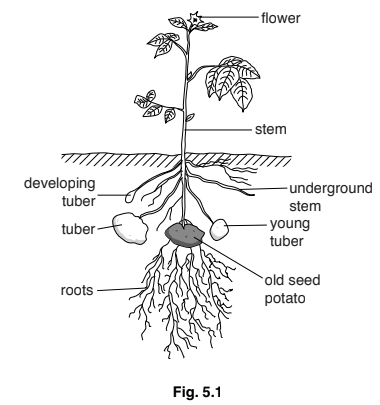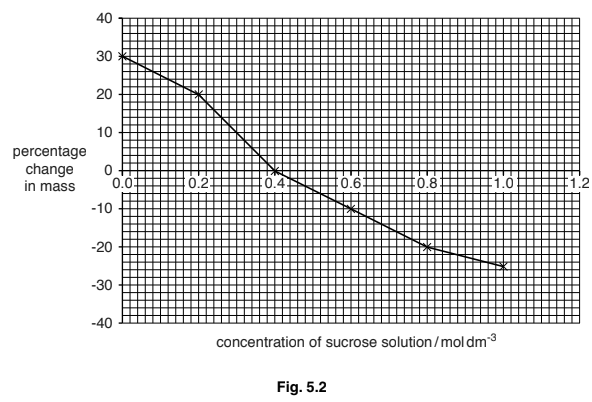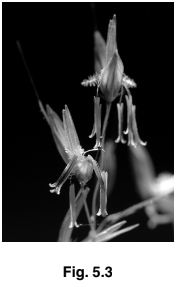Question
Many flowering plants can reproduce sexually and asexually.
(a) (i) Define the term asexual reproduction.
(ii) State one advantage and one disadvantage of asexual reproduction for flowering plants.
(b) Fig. 5.1 shows a potato plant, Solanum tuberosum, grown from a tuber. The tubers that potato plants are grown from are commonly referred to as seed potatoes.

(i) Define the term growth.
(ii) Potatoes can reproduce asexually by means of tubers. The parent plant produces underground stems, which eventually form tubers.
With reference to Fig. 5.1, describe how tubers are formed from the underground stems in potatoes.
(c) A student conducted an experiment to investigate the percentage change in mass of potato tuber tissue when placed in different concentrations of sucrose solution. The potato tuber tissue was
cut into cubes of the same size.
Fig. 5.2 shows a graph of the results.

(i) Use Fig. 5.2 to predict the percentage change in mass of a cube of potato tuber tissue placed in 1.2 mol dm–3 sucrose solution.
(ii) Explain the results shown in Fig. 5.2 in terms of water potential:
• between sucrose concentrations of 0.0 – 0.4 mol dm–3
• at sucrose concentration 0.4 mol dm–3
• between sucrose concentrations of 0.4 – 1.0 mol dm–3.
between 0.0 – 0.4 mol dm^{–3} …………………………………………………………………………………..
at 0.4 mol dm^{–3} …………………………………………………………………………………………………….
between 0.4 – 1.0 mol dm^{–3} …………………………………………………………………………………..
(d) Pollination is the transfer of pollen from the anther to the stigma. Pollen can be transferred to the stigma by being carried by the wind or by animals.
Fig. 5.3 shows a photograph of a wind-pollinated flowering plant.

(i) State two structural adaptations of a flower for wind-pollination.
(ii) State how self-pollination differs from cross-pollination.
(iii) Suggest one reason why self-pollination might be advantageous to a population of plants.
Answer/Explanation
Ans:
(a) (i) production of genetically identical offspring ;
from one parent ;
no gametes /(only) mitosis ;
(ii) advantage
fast ;
colonise new areas quickly ;
if the parent is well adapted to the environment the offspring will be also/AW ;
only one individual needed ;
disadvantage
little/ no, variation ;
disease/ change in environmental conditions, likely to kill all organisms /AW ;
limited ability to adapt to environmental changes /AW ;
no dispersal, so competition (with parent/others) likely ;
(b) (i) increase in, size/ length/mass / volume/AW ;
increase in cell number ;
(ii) sucrose transported (to underground stems) ;
through phloem/ translocation ;
sucrose converted to starch ;
stem swells ;
AVP ;
(c) (i) – (negative);
25 — 40 ;
(ii) Accept the following 3 marking points written anywhere in response:
1 correct reference to osmosis ;
2 cell membrane is, partially / semi/ selectively permeable ;
3 reference to movement of water down a water potential gradient ;
between 0.0 mol dm^{–3}–0.4 mol dm^{–3}
4 water moves into the potato ;
5 potato has a lower water potential than surroundings /ora ;
6 increasing the potato’s mass ;
at 0.4 mol dm^{–3}
7 potato has the same water potential as the surroundings ;
8 there is no net movement of water ;
between 0.4 mol dm^{–3} – 1.0 mol dm^{–3}
9 potato has a higher water potential than the surroundings ora;
10 water moves out of the potato ;
11 decreasing the potato’s mass ;
(d) (i) long filaments ;
anthers / stamens, hang outside/anthers / stamens, easily exposed to the wind ;
anthers loosely attached to the filaments ;
small/ light, pollen ;
large/ feathery / hairy, stigma ;
stigma/ style, hangs outside ;
no/reduced, petals ;
(ii) self-pollination is within the same, plant/flower ;
cross-pollination is between different plants ;
(iii) more chances of fertilisation ;
no need for pollinators ;
useful if plants are, geographically isolated/on their own/AW ;
if well suited to the environment the traits are kept/AW ;
less energy required for reproduction/ less wastage of pollen ;
AVP ;
